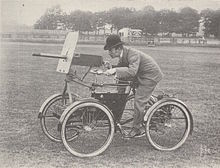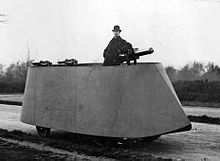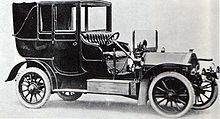Frederick Richard Simms
Frederick Richard Simms (born August 12, 1863 in Hamburg , † April 21, 1944 near London ) was a British industrialist and automobile pioneer .
Life
Frederick R. Simms was the second son of Frederick Louis Simms and Antonia Simms, nee Hermans. He was the younger brother of Henry B. Simms , the art collector and owner of a successful Hamburg import-export company. The English-born grandfather was a businessman in Hamburg and had brought the family to prosperity and respect. When he was young, Simms lived partly in Hamburg and partly in London. He trained at the Polytechnic Association and the AG for Automatic Sales in Berlin.
Frederick Richard Simms was married twice. He married his first wife, Lucie Sophie Wilhelmina Beate Greiff, on April 29, 1903 in the fine St. Georgs Church in London. She was Austrian; nothing further is known about her and her family. The marriage did not last long. After only a year she sued him for restitution of marital rights. They finally divorced in May 1909. He married his second wife, Mabel Louise Worsley, in 1910. She was the daughter of a Lancashire cotton merchant. The couple had two daughters. Pamela and Rosemary Mabel. Rosemary married the painter Dennis Ramsay .
For many years the family lived in Storth Oaks in Chislehurst , Kent . Mabel Louise died there in 1940. Frederick R. Simms followed her in 1944 at the age of 81. His ashes were buried next to his wife in the Buckinghamshire cemetery.
Simms and the automotive industry

Daimler
In 1889, as a German with an English passport, the 26-year-old Frederick Simms met Gottlieb Daimler at the technology exhibition in Bremen and became friends with him. From 1891 he imported engines from Daimler and in 1893, together with Harry Lawson (1852–1925), founded Daimler Motor Syndicate Ltd. what is believed to be the beginning of the UK automotive industry.
In 1894, Simms Gottlieb enabled Daimler to return to the Daimler-Motoren-Gesellschaft , which he had left because of financial problems. The acquisition of a license for Daimler's invention for Great Britain and the colonies, with which he saved the DMG from ruin, was linked to the resumption of Daimler in the company. In 1895 these rights went to the Daimler Motor Syndicate, which was associated with a "substantial" commission for Simms. She in turn sold this for GB £ 35,000 to Lawson, who sold it on for a profit to the Daimler Motor Company founded in Coventry in June 1896 , in which Lawson was chairman and in which Gottlieb Daimler and Frederick W. Lanchester were involved. Together with Otto Mayer, Simms organized the first sale of a truck with a combustion engine for Gottlieb Daimler , which was delivered to the Daimler Motor Syndicate on October 1, 1896 as a commercial vehicle , a " carriage without a drawbar" and used for road transport to London.
The Daimler Motor Syndicate went up in the British Motor Syndicate , also controlled by Lawson , who used it as a vehicle to build up his vehicle empire and applied dubious business methods; eventually the construct collapsed after a huge financial scandal.
A letter from Simms dated February 8, 1891 is the first written evidence for the word "Motorcar". Supposedly, Simms coined the term "petrol" for gasoline.
Simms-Welbeck
The Simms Manufacturing was a British automobile manufacturer which was based in Willesden near London from 1903 to 1907. The company has been delivering vehicles in one-off production since the turn of the century. Series production did not begin until 1903. The vehicles were offered under the names Simms or Simms-Welbeck . Mainly it was four-cylinder models. In addition to two two-cylinders, a six-cylinder model was also delivered. The Simms-Welbeck automobiles were the first automobiles to be fitted with bumpers in 1905 . The cars were considered reliable, but could not hold up on the market. In 1907 the company closed its doors forever.
London-Brighton Run and Motor Car Club
In February 1896, Simms and Lawson founded the "Motor-Car-Club" as the first association to promote motor vehicles and for political lobbying . The club's first secretary was Charles Harrington Moore , and Lawson provided the office. From May to August 1896, a motor vehicle exhibition organized by Moore was held at the Imperial Institute in London. It was one of the first of its kind in Great Britain and brought the Prince of Wales , later King Edward VII, into contact with the automobile. The association had other influential members and supporters. Not least thanks to the association's lobbying activities, Parliament repealed the Red Flag Act of 1865 at the end of 1896 . He had stipulated that a vehicle without horses (originally steam cars and traction engines ) should travel at a maximum speed of 4 mph (approx. 6.5 km / h) on country roads and 2 mph (approx. 3 km / h) in towns could. It also stipulated that the vehicle had to be occupied by two people and that a pedestrian with a red flag had to go ahead.
This law was seen as one of the main obstacles facing the UK auto industry and was vehemently opposed by Simms and Lawson. As a result, Lawson, Simms and Moore's successor as secretary, C. Herbert Goodwin , organized a race from London to Brighton known as the Emancipation Run . Lawson and Simms were among the 33 participants (only 13 of whom got to Brighton on time); the latter accompanied Gottlieb Daimler with his new belt car . Lawson had recently bought the Panhard with which Émile Levassor had won the Paris – Bordeaux – Paris race in 1895 over 1175 km. Daimler was shown the superiority of the French design (with a Daimler license engine); this can be seen as a cause of the later alienation between Daimler and Wilhelm Maybach . The race has been held annually on the first weekend in November since 1927 as the London to Brighton Veteran Car Run and is considered the oldest event for veteran vehicles in the world.
From December 1896 to 1899, Charles Jarrott was the club's secretary.
Royal Automobile Club

In 1897 Simms was one of the initiators of the "Automobile Club of Great Britain & Ireland" (ACSGB & I.), which was renamed "Royal Automobile Club" in 1907 with the permission of King Edward VII .
SMMT and auto shows
In 1901, Simms initiated the establishment of an industry association for the British vehicle and engine industry and was involved in its establishment in 1902 as the Society of Motor Manufacturers & Traders (SMMT). This organization still exists today as a lobby group for the British vehicle and engine industry . Analogous to the German Association of the Automotive Industry (VDA), the SMMT is the national representation in the Association des Constructeurs Européens d'Automobiles (ACEA).
The other first signatories were Henry George Burford (1867–1943) from British Daimler and Humber , James Sydney Critchley (1866–1944) from the British Electric Traction Company , Selwyn Edge (controlled parts of the automobile industry; represented Napier and was Panhard importer ), Richard Farman (an aviator; his brothers Henri and Maurice Farman were racing drivers and later built Farman planes and automobiles), Charles Jarrott (importer of De Dion-Bouton and De Dietrich ) and Sir William Malmsbury Letts (managing director of Locomobile of Great Britain and Jarrot's business associate; later controlling Crossley and aircraft manufacturer Avro ).
The SMMT organized its first exhibition in 1903 at the Crystal Palace ; this is the forerunner of the British International Motor Show .
Simms Motor War Car
Simms was convinced that the future belongs to the automobile in warfare too, and in 1899 he developed a lightly armored four-wheeler with an automatic fire weapon and a fully armored car , which, however, met with no interest from the military. The Simms' Motor War Car was the first armored automobile ever built. It was designed by Simms in 1899 and ordered from Vickers, Sons & Maxim . Due to various mishaps at Vickers, it wasn't finished until early 1902, after the end of the Boer War.
Simms-Bosch
At the turn of the century, Robert Bosch had found a market hit: magneto ignition for motor vehicles. Simms helped the Stuttgart manufacturer financially. The first foreign agency in London in 1899 was of great importance for the early history of Bosch. Simms made a significant contribution to the Bosch magneto ignition becoming established abroad. Due to personal differences, the partnership failed in 1906. Bosch felt Simms' business conduct was unfair. He was glad to finally be able to cash out Simms.
Simms Motor Units
Simms founded the Simms Motor Units in 1913. During the First World War, the company became the main supplier of magneto ignition systems to the British Army. That continued in World War II. The company became the main supplier of magnetos for aircraft and tanks. Alternators, starters, lighting, pumps, nozzles, spark plugs and coils were also part of the delivery range.
Simms and the Alps
In 1893, Simms asked the court in Vienna about a wild, romantic and beautiful hunting ground. On the basis of a personal recommendation from Emperor Franz Josef , Simms came to Holzgau in the upper Lech Valley for the first time at the age of 30. There he went on mountain tours and realized that a refuge was required on the way. He then offered the Holzgau section of the DuOeAV to finance the construction. In 1907 the hut was built on an avalanche-proof place. Simms awakened his passion for hunting in Robert Bosch, his close business partner. In 1925, the Stuttgart Section took over the hut on a lease basis. The merger of the two sections took place in 1938. Later it was completely owned by the Alpine Club . Rebuilt in 1956, it bears the name "Frederick Simms Hut" , as evidenced by a portrait of the founder.
The Simms waterfall was artificially created by Frederick Simms at the turn of the century. The Höhenbach was restored to its original course by blasting . For millennia it flowed over this rocky crest and thundered down into the valley like today in a deep fall.
literature
- David Culshaw, Peter Horrobin: The Complete Catalog of British Cars 1895-1975 , Veloce Publishing PLC, Dorchester (1997); ISBN 1-874105-93-6 .
- Jonathan Wood: The British Motor Industry Shire Publications Ltd (2010); ISBN 0-7478-0768-X .
- Hans Christoph von Seherr-Thoss : Dictionary of famous personalities in the automobile world. Ivy House Publishing, Raleigh NC, USA, 1st edition; 2005; ISBN 1-57197-333-8 .
- Anthony Bird: De Dion Bouton - First Automobile Giant. Ballantine's Illustrated History of the Car marque book No 6, 1971, Ballantine Books Inc. 101 Fifth Ave., New York, No. 02322-6
- Bernard Vermeylen: Panhard & Levassor. Entre tradition et modernité. ETAI, Boulogne-Billancourt, 2005; ISBN 2-7268-9406-2 .
Web links
- Frederick R. Simms website
- History of the Royal Automobile Club (RAC ) (accessed March 25, 2016)
- Grace's Guide: Frederick Simms. (Accessed November 27, 2016)
- Grace's Guide: Harry Lawson. (Accessed November 27, 2016)
- Grace's Guide: Motor Car Club. (Accessed November 27, 2016)
- Grace's Guide: Society of Motor Manufacturers and Traders (SMMT ) (accessed November 25, 2016)
- Grace's Guide: Henry George Burford. (Accessed November 27, 2016)
- Grace's Guide: James S. Critchley. (Accessed November 27, 2016)
- Grace's Guide: Selwyn Edge. (Accessed November 27, 2016)
- Grace's Guide: Charles Jarrott & Letts. (Accessed November 25, 2016)
- Grace's Guide: Charles Jarrott. (Accessed November 27, 2016)
- Grace's Guide: William Malmsbury Letts. (Accessed November 27, 2016)
Individual evidence
- ^ Richard A. Storey, 'Simms, Frederick Richard (1863–1944)', Oxford Dictionary of National Biography, Oxford University Press, 2004
- ↑ Death of Mr. FR Simms, The Times, Monday Apr 24, 1944; pg. 6th
- ↑ Seiffert: The era of Gottlieb Daimler: New Perspectives on the Early History of the Automobile and its Technology (2009), p. 140.
- ↑ Grace's Guide: Harry Lawson.
- ↑ Trucks - history, technology, types - page 14. GeraMond-Verlag, 2007, ISBN 978-3-7654-7804-8
- ↑ a b Grace's Guide: Motor Car Club.
- ^ Seiffert: Gottlieb Daimler's era: New perspectives on the early history of the automobile and its technology (2009), p. 153.
- ↑ Grace's Guide: Charles Jarrott.
- ↑ a b Grace's Guide: Charles Jarrott & Letts.
- ↑ Grace's Guide: William Malmsbury Letts.
| personal data | |
|---|---|
| SURNAME | Simms, Frederick Richard |
| BRIEF DESCRIPTION | British automobile pioneer |
| DATE OF BIRTH | August 12, 1863 |
| PLACE OF BIRTH | Hamburg |
| DATE OF DEATH | April 21, 1944 |
| Place of death | near London |






